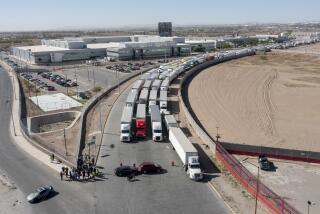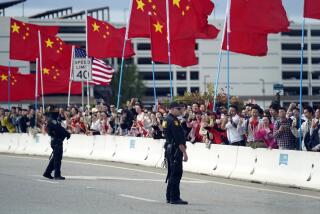U.S. Business Waits in Wings as Diplomats Talk Free Latin Trade : Summit: Financial services, telecommunications firms and energy equipment makers see huge markets.
- Share via
The agenda at this weekend’s Summit of the Americas in Miami may accent lofty themes, but U.S. business leaders reading between the lines see nothing but concrete opportunities coming out of any move toward hemispheric free trade.
U.S. financial services, telecommunications companies and energy equipment manufacturers see huge markets opening up in Latin American countries just now emerging from protectionist regimes and registering rapid economic gains. A Western Hemispheric free trade pact, the goal that each of the 34 nations is striving for, would only accelerate those gains.
A few of the eager observers: AT&T;, which stands ready to wire Latin America with fiber optic; Salomon Bros., which would like to prime the emerging economies’ pumps with capital; Weyerhaeuser Co., which wants to sell timber products, and Santa Fe Pacific, whose port facilities in Los Angeles and San Diego would exploit the extra ship traffic.
“What we want to see is the opening of markets generally throughout Latin America, the deregulation of telecommunication services and the opportunity for companies like AT&T; to compete in those markets for both equipment and services,” said Victor Pelson, chairman of AT&T;’s global operations team based in New York.
In fact, the summit’s goal statement specifically targets telecommunications, capital markets and energy----prerequisites for the infrastructure needed to better link member countries. In Brazil, for example, there are just seven telephones for every 100 residents--compared with 56 per 100 in the United States.
Closing such gaps demands high-cost, high-technology projects that are traditionally U.S. industry’s bread and butter.
“The economies of Latin America are in the take-off stage and there are some substantial projects in the planning boards. We’re talking about billions of dollars of sales over next few years in telecom and natural gas pipelines alone,” said Jeffrey J. Schott, senior fellow at Institute for International Economics, a Washington, D.C., think tank.
U.S. trade with Latin America is gathering steam anyway. The United States turned a $2.8-billion trade surplus with the region over the year ended September, a surplus likely to grow rapidly over the next decade. Maintaining or improving that surplus with freer trade is a high priority with the U.S. trade deficit worldwide mushrooming to $108.5 billion last year.
But there will be some bumps along the road to free trade’s level playing field. Far-reaching reforms of Latin American judicial systems and stock exchanges must be completed, for example, before U.S. investors are comfortable doing business there.
Joyce Chang, emerging markets research director at Salomon Bros., said $66 billion in U.S. capital flowed into Latin American stocks and bonds this year as investors were attracted by higher bond interest rates and booming stock markets. But that number would go much higher if certain Latin countries eliminated barriers to foreign investment, she said.
Several countries are in dire need of stock exchange reforms that set up uniform rules for clearance and settlement so as to “guarantee that buyers get their stock and that sellers get their money,” said an official with the Inter-American Development Bank in Washington, D.C. “The courts have to be streamlined so if they have a dispute, it doesn’t take five or six years to resolve it.”
The leveling process will require significant U.S. concessions as well. Several Latin American countries complain about U.S. trade policy that protects domestic agricultural interests. They noted that the recently approved worldwide General Agreement on Tariffs and Trade, a set of rules that govern international trade, is less stringent about freeing up markets for agriculture than for industrial products.
Argentina, for example, wants the United States to stop subsidies for wheat farmers. Chile says it can’t sell enough table grapes here. Colombia is mad about tariffs on its cut flowers, which once dominated the U.S. market. Brazil says it is prevented from exporting all the orange juice concentrate that it can produce.
And Caribbean countries want to regain the preferential treatment for textiles they lost with last year’s passage of the North American Free Trade Agreement, the trade pact among Canada, Mexico and the United States.
“The U.S. subsidizes its wheat farmers and the Canada Wheat Board has an internal monopoly. So they can afford to go on dumping in other markets such as Brazil just like some Japanese electronics companies . . . in the U.S.,” said an official at the Argentine Embassy in Washington.
Lower priced American wheat sold in Brazil has severely damaged Argentine farmers for whom Brazil is the largest export market, complained the Argentine spokesman, who asked not to be named.
Gustavo de Grieff, director of Colombia’s trade bureau in Los Angeles, said the United States protects Hawaiian banana growers with strict quotas that effectively block Colombia’s access to U.S. markets. That’s a damaging blow at a time when the European common market is freezing out Colombian and Ecuadorean banana farmers.
But those issues are seen as relatively minor irritants in relation to the overall benefit of a hemispheric trade agreement. And the pressure is on President Clinton to lead the summit toward that goal this weekend, despite the disappointing November elections and his recent failure to obtain “fast track” negotiating authority from Congress to expand NAFTA to other countries.
(BEGIN TEXT OF INFOBOX / INFOGRAPHIC)
America’s Export Customers
U.S. export figures illustrate the importance of Western Hemisphere trade to the United States. Although the United States is suffering from a deficit in overall world trade, it enjoys a $2.8-billion surplus with with Latin American countries.
Western Hemisphere: $150.4 billion (40%)
Pacific Rim Countries: $109.1 billion (29%)
European Union: $74.9 billion (20%)
Other: $40.0 billion (11%)
Other includes Africa, Eastern Europe, the Middle East and former Soviet Union countries. Figures are for the 12-month period ended September, 1994.
Source: Commerce Department
More to Read
Inside the business of entertainment
The Wide Shot brings you news, analysis and insights on everything from streaming wars to production — and what it all means for the future.
You may occasionally receive promotional content from the Los Angeles Times.










